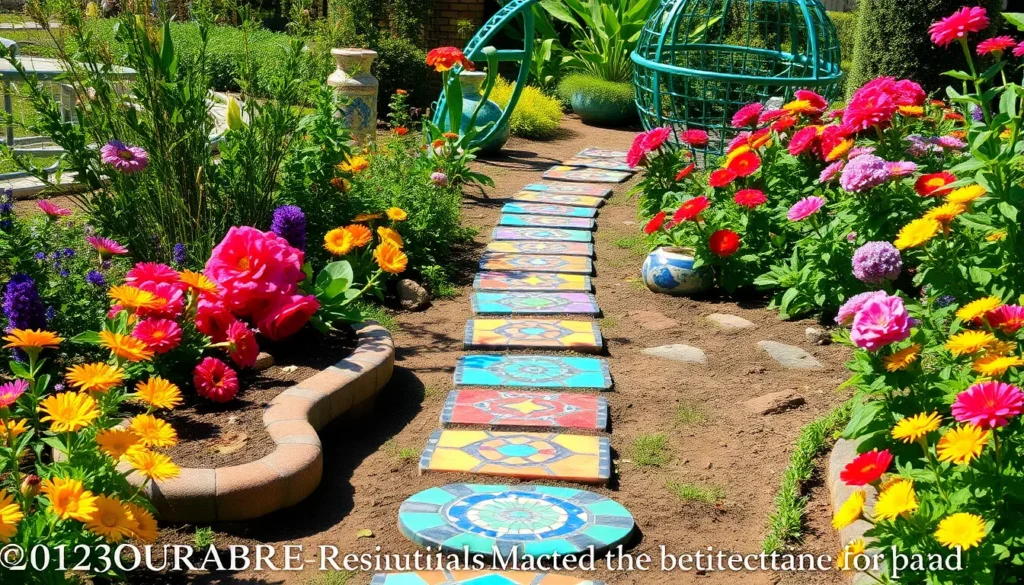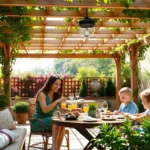Garden mosaics transform ordinary outdoor spaces into stunning works of art that catch every visitor’s eye. We’ve discovered that these colorful installations don’t just add visual appeal – they create focal points that make your garden truly unforgettable. Whether you’re working with broken pottery, colorful tiles, or natural stones, mosaic projects offer endless possibilities to express your creativity.
The beauty of garden mosaics lies in their versatility and durability. We can incorporate them into stepping stones, planters, garden walls, or even create standalone sculptures that weather beautifully through seasons. These artistic elements work perfectly in any garden style, from modern minimalist designs to cottage-style landscapes.
What makes garden mosaics particularly appealing is their accessibility to gardeners of all skill levels. We’ll show you how simple techniques can produce professional-looking results that’ll have your neighbors asking for your secret. Ready to turn your garden into an outdoor gallery that reflects your unique style?
Create Stunning Stepping Stone Mosaics for Garden Pathways
Stepping stone mosaics transform ordinary garden paths into artistic walkways that guide visitors through your outdoor space. We’ll explore the essential elements that make these functional art pieces both beautiful and enduring.
Choose Durable Materials for Weather Resistance
Natural stone tiles provide the foundation for weather resistant stepping stone mosaics that withstand freeze thaw cycles and heavy foot traffic. We recommend using granite, slate, or quartzite pieces that maintain their color and texture through seasonal temperature changes.
Ceramic materials offer vibrant color options when selecting frost proof varieties specifically designed for outdoor use. Porcelain tiles rated for outdoor applications resist moisture absorption and prevent cracking during winter months.
Glass mosaic pieces create stunning light reflective surfaces when you choose tempered varieties that won’t shatter under pressure. Marine grade glass tiles designed for pool applications perform exceptionally well in garden environments.
Concrete bases should measure at least 2 inches thick to support the mosaic materials without cracking or shifting over time. We suggest using fiber reinforced concrete mixed with polymer additives that increase flexibility and reduce water penetration.
Design Patterns That Complement Your Industry Style
Geometric patterns work beautifully in modern garden settings where clean lines and structured plantings dominate the industry design. Square grids, hexagonal shapes, and diamond configurations create contemporary stepping stones that complement minimalist outdoor spaces.
Organic flowing designs suit cottage gardens and naturalistic landscapes where curved pathways wind through informal plantings. Spiral patterns, leaf motifs, and abstract swirls echo the natural forms found in your existing garden elements.
Color coordination connects your stepping stone mosaics to surrounding industry features through strategic material selection. We recommend pulling accent colors from nearby flower beds, garden structures, or outdoor furniture to create visual harmony.
Scale considerations ensure your mosaic patterns remain visible and impactful when viewed from walking height. Larger pattern elements measuring 4 to 6 inches across provide better definition than intricate details that disappear from normal viewing distances.
Install Properly for Long-Lasting Beauty
Base preparation requires excavating 6 inches deep and creating a level foundation using compacted gravel topped with sand leveling layer. We recommend using industry fabric beneath the gravel to prevent weed growth and maintain stable drainage.
Adhesive selection determines the longevity of your mosaic installation in outdoor conditions exposed to moisture and temperature fluctuations. Polymer modified thinset adhesives specifically formulated for exterior applications provide superior bonding strength and flexibility.
Grouting techniques protect individual mosaic pieces while allowing proper water drainage around each stepping stone. We suggest using sanded grout mixed with acrylic additives that resist staining and maintain flexibility through seasonal movement.
Sealing procedures preserve the appearance and integrity of your stepping stone mosaics through regular maintenance applications. Apply penetrating sealers annually to natural stone materials and topical sealers every two years to ceramic and glass components.
Transform Plain Planters With Colorful Mosaic Designs
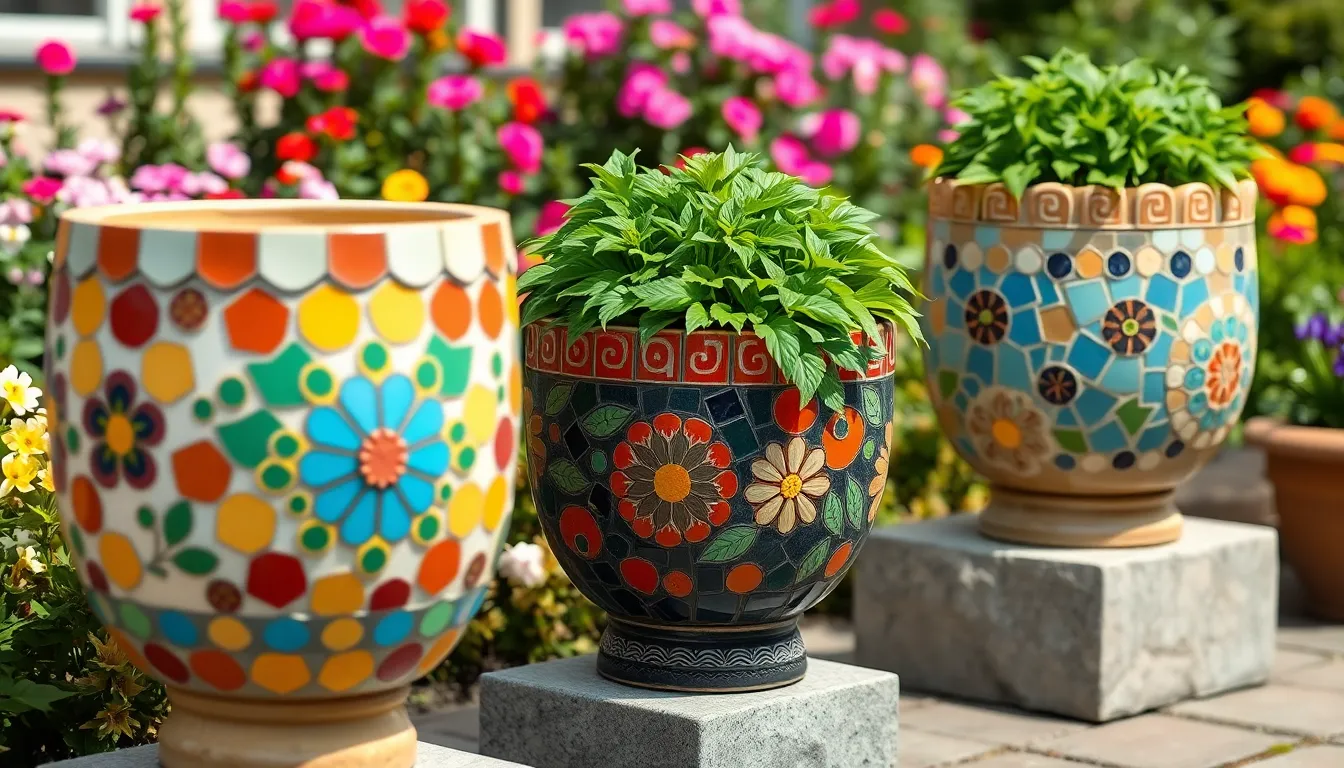
We’ll breathe new life into ordinary containers by applying vibrant mosaic patterns that turn functional planters into stunning garden art pieces.
Select Appropriate Containers and Prepare Surfaces
Choose containers that can withstand outdoor conditions while providing a stable foundation for your mosaic masterpiece. Ceramic pots, concrete planters, and terra cotta vessels work exceptionally well because they offer excellent adhesion properties and weather resistance.
Clean surfaces thoroughly before beginning your project to ensure strong bonds between adhesive and mosaic materials. Remove all dirt, oils, and debris using a degreasing cleaner, then allow containers to dry completely for 24 hours.
Sand glossy surfaces lightly with fine-grit sandpaper to create better texture for adhesive attachment. This step becomes crucial when working with glazed ceramic or smooth plastic containers that might otherwise reject your mosaic materials.
Incorporate Seasonal Color Schemes
Tailor designs to match seasonal themes by selecting colors that reflect nature’s changing palette throughout the year. Summer projects shine with warm oranges, vibrant yellows, and energetic reds, while winter designs benefit from cooler blues, pristine whites, and elegant silvers.
Blend materials strategically using glass tiles for brilliant color saturation, stone pieces for natural texture, and ceramic fragments for durability. Each material contributes unique visual properties that enhance your seasonal color story.
Enhance themes with natural elements like shells for coastal summer vibes or smooth river stones for autumn earthiness. These organic additions connect your mosaic planters directly to seasonal garden changes while maintaining artistic cohesion.
Add Drainage Considerations for Plant Health
Ensure adequate drainage by maintaining existing holes in your containers or carefully drilling new ones after completing your mosaic work. Plants require proper water flow to prevent root rot and maintain healthy growth patterns.
Apply waterproof sealant around drainage areas and across the entire mosaic surface to protect your artwork from moisture damage. Quality sealants extend the lifespan of your decorative planters while maintaining their vibrant appearance through multiple growing seasons.
Position planters on raised surfaces or pot feet to improve air circulation beneath containers and prevent water stagnation. This simple step protects both your mosaic investment and plant health simultaneously.
Design Eye-Catching Mosaic Garden Walls and Fences
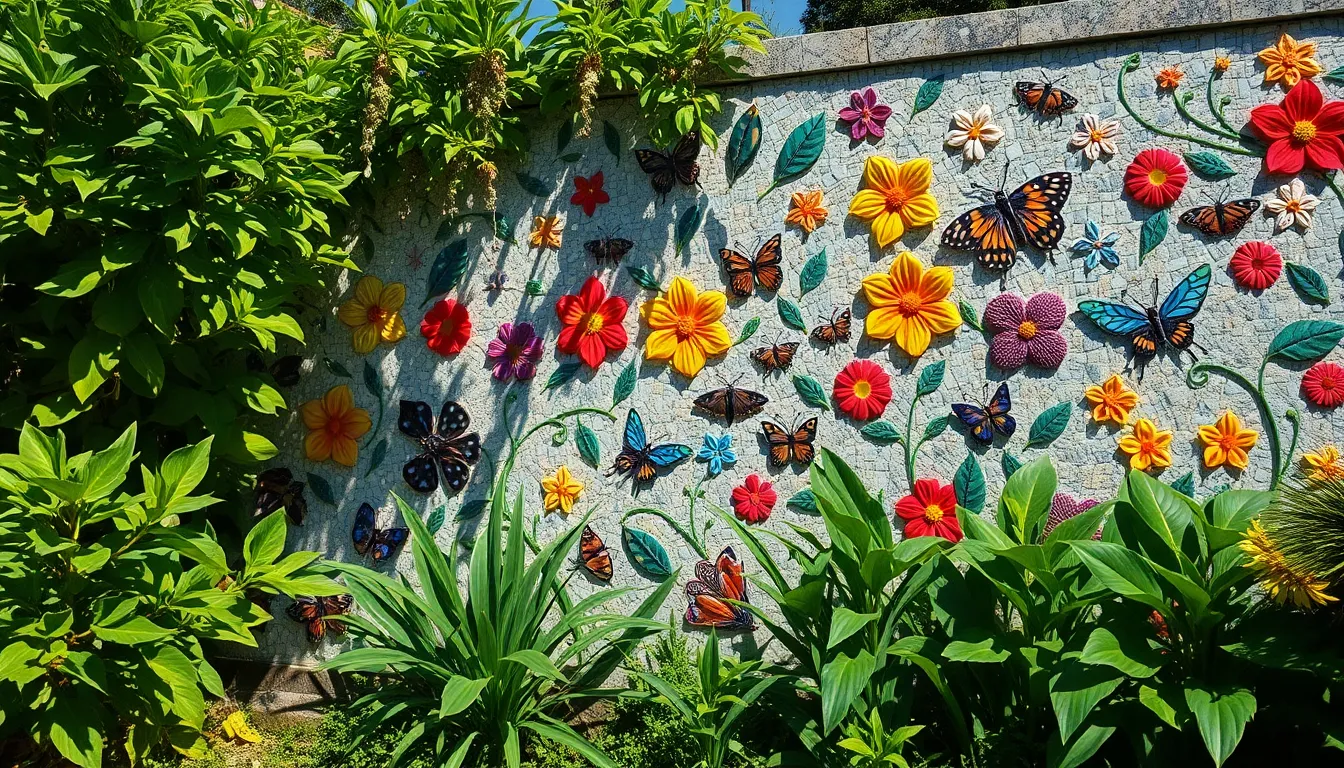
Transform bare walls and fences into stunning artistic features that serve as dramatic backdrops for your entire garden space. Large vertical surfaces offer unlimited potential for creating breathtaking mosaic displays that captivate visitors and define your outdoor aesthetic.
Plan Large-Scale Patterns for Maximum Impact
Nature inspired designs work exceptionally well when covering expansive wall surfaces, allowing you to incorporate flowers, insects, and other organic elements that reflect your garden’s natural beauty. Create cohesive themes by using consistent color palettes across multiple sections, ensuring your mosaic walls complement rather than compete with surrounding plantings.
Scale your patterns appropriately for the viewing distance, remembering that designs meant to be seen from across the garden need bolder elements than intimate courtyard features. Consider the wall’s orientation and how natural light will interact with your chosen materials throughout different times of day.
Seasonal considerations play a crucial role in pattern selection, as certain designs may look dramatically different under summer sun versus winter’s muted lighting conditions.
Use Mixed Media for Texture and Visual Interest
Material variety creates stunning visual depth when you combine marble, glass, stone, and wood tiles within the same installation. Different textures catch and reflect light uniquely, adding ever-changing movement to static wall surfaces as viewing angles change throughout the day.
Dimensional effects emerge when you incorporate three dimensional elements or irregular shapes that break away from flat mosaic traditions. Raised sections create shadow patterns that shift with the sun’s movement, while recessed areas provide visual rest points within busy designs.
Contrasting finishes between matte and glossy materials amplify the textural interest, with smooth glass pieces highlighting the rougher textures of natural stone elements.
Consider Privacy and Functionality Needs
Privacy screens become artistic statements when you adorn walls or fences with intricate mosaic designs that block unwanted views while creating beautiful focal points. Strategic placement of denser patterns at eye level provides maximum screening while allowing lighter designs above and below.
Functional elements like mosaic covered flowerpots, benches, or tables integrate seamlessly with wall designs when you coordinate colors and patterns across all surfaces. These unified design approaches create sophisticated outdoor rooms that feel professionally designed.
Aquatic themes using water inspired murals, such as koi pond or sea life designs, work particularly well for creating immersive environments that transport visitors to serene underwater worlds.
Build Decorative Mosaic Garden Tables and Seating
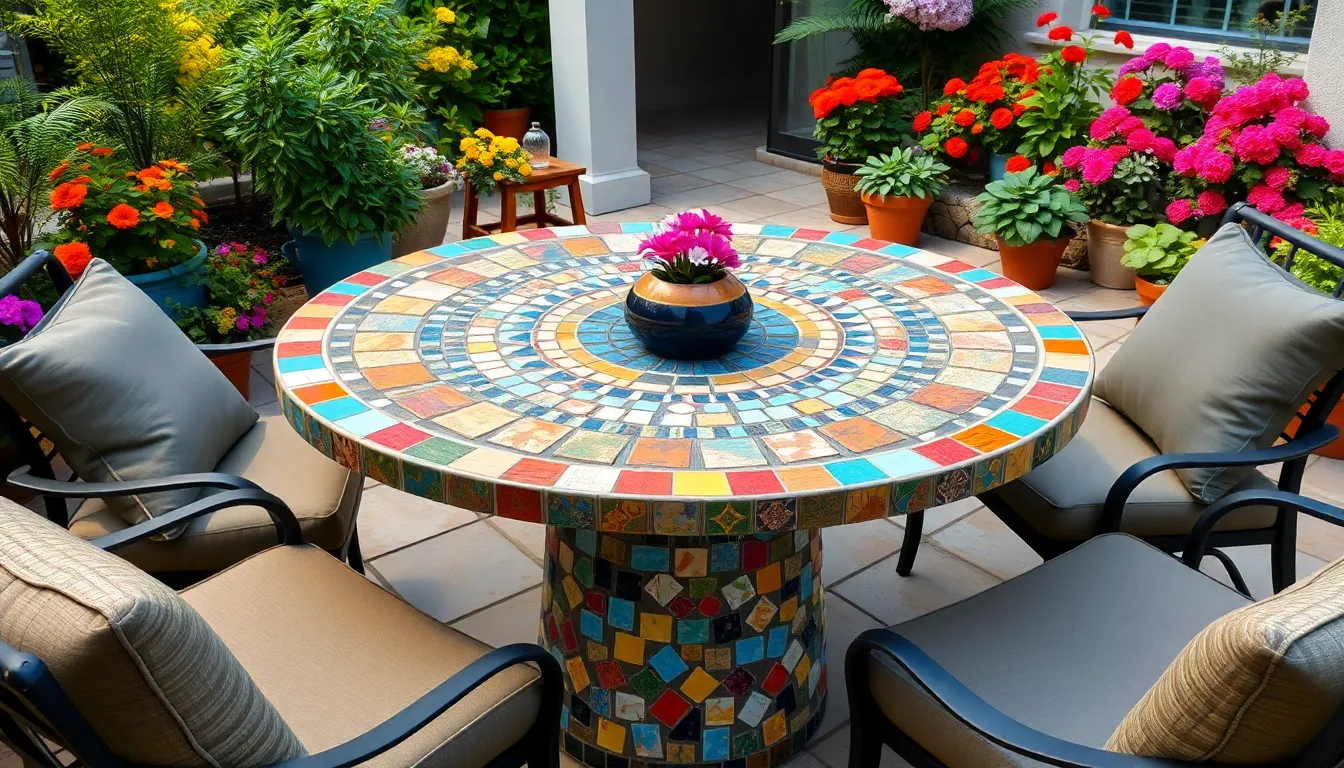
Garden tables and seating transform into stunning focal points when adorned with carefully crafted mosaic designs. We can create functional furniture pieces that serve as both practical surfaces and captivating art installations throughout our outdoor spaces.
Create Weather-Resistant Outdoor Furniture
Durability stands as our primary consideration when selecting materials for outdoor mosaic furniture projects. Ceramic tiles, porcelain pieces, and recycled glass provide excellent weather resistance while maintaining their vibrant colors throughout seasons of sun, rain, and temperature fluctuations.
Proper sealing protects our mosaic creations from moisture infiltration and freeze-thaw cycles that could damage the artwork. We apply high-quality outdoor sealants specifically designed for mosaic applications, ensuring our tables and seating withstand years of outdoor exposure without deterioration.
Base construction requires sturdy materials like concrete, treated wood, or metal frames that won’t warp or crack under weather stress. We reinforce these foundations before applying our mosaic designs, creating stable platforms that support both the decorative elements and daily use demands.
Design Functional Art Pieces for Entertaining
Entertainment value increases dramatically when we incorporate interactive design elements into our mosaic furniture pieces. Game boards like chess or checkers become permanent features etched in tile, while serving surfaces accommodate drinks and dining with both beauty and practicality.
Seating arrangements benefit from comfortable proportions combined with artistic flair that encourages guests to linger and appreciate the craftsmanship. We design bench tops and chair backs with smooth, comfortable surfaces while incorporating decorative patterns along edges and side panels.
Storage integration adds functionality to our artistic pieces through built-in compartments or shelving areas enhanced with complementary mosaic work. Hidden storage beneath seat cushions or within table bases maximizes utility while maintaining the aesthetic appeal of our garden furniture.
Match Existing Garden Décor and Color Palette
Color coordination ensures our mosaic furniture enhances rather than competes with existing garden elements and plant selections. We analyze the dominant hues in our industry, from foliage greens to flower colors, then select tiles that complement these natural tones while adding visual interest.
Pattern selection reflects the overall garden style, whether geometric designs suit modern landscapes or organic, flowing motifs enhance cottage garden settings. Natural stone mosaics blend seamlessly with rustic garden themes, while glass tiles and marble pieces elevate more formal outdoor spaces.
Seasonal considerations guide our color choices, allowing furniture pieces to harmonize with changing garden displays throughout the year. Blue glass and marble tiles particularly highlight earthy garden tones, creating striking contrasts that draw attention without overwhelming the natural beauty of our planted areas.
Craft Mosaic Bird Baths and Water Features

Transform your garden’s aquatic elements into stunning focal points with mosaic art that combines functionality with beauty. Bird baths and water features enhanced with colorful tiles create serene gathering spots for wildlife while adding vibrant artistic charm to outdoor spaces.
Ensure Safe Materials for Wildlife
Choose non-toxic materials when creating mosaic bird baths that’ll welcome feathered visitors safely. Smooth glass tiles and glazed ceramics work best because they won’t harm delicate bird feet or beaks during use. Natural stones provide another excellent option since they’re inherently safe and weather resistant.
Avoid sharp tile edges by selecting rounded pieces or carefully smoothing any rough surfaces before installation. We recommend using waterproof grouts and adhesives that are completely free of harmful chemicals. These materials protect visiting wildlife while ensuring your mosaic art remains durable through all seasons.
Test adhesive products by checking their safety certifications before applying them to bird accessible areas. Glazed tiles resist bacteria growth better than porous materials, making them ideal for water contact surfaces where birds drink and bathe.
Design for Easy Cleaning and Maintenance
Select glass tiles or glazed ceramics that resist algae buildup and wipe clean effortlessly during regular maintenance. Smooth surfaces with minimal crevices simplify your cleaning routine while preventing debris accumulation in mosaic joints. Position your bird bath where you can easily reach all surfaces without disturbing surrounding plantings.
Create gentle slopes in your mosaic design that naturally direct water toward drainage points. We suggest incorporating subtle channels between tile sections that help water flow freely rather than pooling in corners. These design features reduce stagnant water problems that attract mosquitoes and create unpleasant odors.
Install filtration systems or small pumps in larger water features to maintain freshness automatically. Simple overflow drains prevent water from becoming stagnant during rainy periods when natural evaporation can’t keep pace with accumulation.
Position for Optimal Garden Views
Place mosaic bird baths where they’re easily visible from indoor windows, patios, and favorite garden seating areas. We position these features along natural sight lines that draw the eye through garden spaces while creating pleasant focal points. Partially shaded locations work best because they highlight colorful tile work without creating harsh glare during bright sunlight.
Frame your water features with complementary plantings that enhance rather than obscure the mosaic artwork. Low growing perennials and ornamental grasses provide perfect backdrops that showcase tile patterns while offering birds nearby shelter. Consider seasonal plant changes that’ll keep your mosaic displays interesting throughout the year.
Connect bird baths to garden pathways using mosaic stepping stones that create visual continuity throughout your industry design. These connecting elements guide visitors naturally toward your water features while extending the artistic theme across broader garden areas.
Make Mosaic Garden Markers and Plant Labels
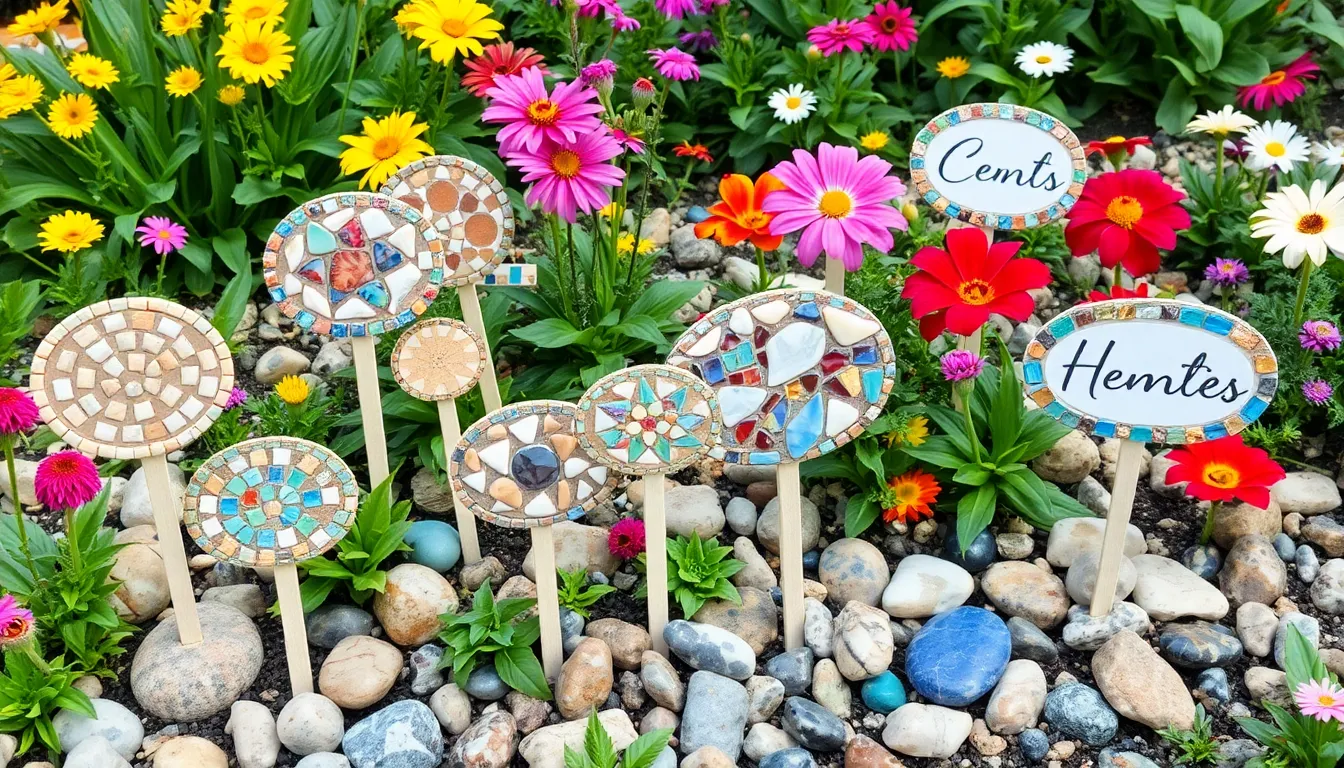
Transform your garden organization into an artistic statement with handcrafted mosaic markers that blend functionality with creative flair. These durable identification systems help you track plantings while adding decorative touches throughout your outdoor space.
Use Readable Fonts and Contrasting Colors
Large, clear fonts ensure your mosaic plant labels remain visible from walking distances throughout the garden. We recommend creating letters at least 2 inches tall to maintain readability even when viewed from several feet away. Bold, simple typefaces work best since intricate scripts become difficult to decipher when constructed from small tile pieces.
Contrasting color combinations dramatically improve text visibility in various lighting conditions. Bright white or yellow tiles against dark blue or black backgrounds create stunning readability that works well in both sunny and shaded garden areas. Light colored letters on deep green or burgundy surfaces also provide excellent contrast while blending naturally with surrounding foliage.
Strategic color placement helps maintain consistency across your garden labeling system. Using the same background color family throughout creates visual harmony while allowing plant names to stand out clearly. Consider seasonal lighting changes when selecting your color palette, as morning shadows and afternoon sun can affect how well certain combinations appear.
Choose Materials That Withstand Outdoor Elements
Outdoor safe adhesives and sealants protect your mosaic markers from moisture damage and temperature fluctuations year round. We always recommend using waterproof tile adhesive specifically designed for exterior applications rather than standard indoor products. These specialized adhesives maintain their bond strength through freeze thaw cycles and heavy rain exposure.
Concrete, stone, and foam core tile backer boards provide the most durable foundation for garden markers. Natural stone bases offer exceptional longevity and complement organic garden designs beautifully. Concrete backing boards allow for custom shapes and sizes while maintaining structural integrity in harsh weather conditions.
UV resistant materials prevent fading and deterioration from constant sun exposure. Glass tiles, ceramic pieces, and porcelain fragments maintain their vibrant colors much longer than painted or plastic alternatives. All mosaic components should be rated for outdoor use to ensure your markers look fresh season after season.
| Material Type | Weather Resistance | Durability Rating | Best Use Cases |
|---|---|---|---|
| Ceramic tiles | Excellent | 8-10 years | Plant names, decorative borders |
| Glass pieces | Superior | 10+ years | Colorful accents, letter details |
| Natural stone | Outstanding | 15+ years | Permanent markers, pathway labels |
| Concrete base | Excellent | 10-15 years | Custom shapes, embedded designs |
Create Cohesive Labeling Systems
Consistent design elements throughout your garden markers establish visual unity while maintaining practical functionality. Using the same border pattern, font style, or color scheme across all labels creates a professional appearance that enhances your garden’s overall aesthetic. Blue glass borders or recurring leaf motifs help tie individual markers together into a coordinated system.
Standardized sizing makes your labeling system easier to navigate and more visually pleasing. We suggest creating markers in two or three consistent dimensions rather than random sizes that can appear chaotic. Uniform heights also ensure all text remains at comfortable reading levels for garden visitors.
Strategic placement patterns guide visitors naturally through your garden spaces while showcasing your mosaic artistry. Position markers at consistent intervals along pathways or group them logically by plant families to create intuitive navigation. Stepping stones with embedded plant names blend seamlessly with traditional stake mounted labels for comprehensive garden organization.
Design Mosaic Garden Borders and Edging

Garden borders and edging offer our most practical opportunity to introduce mosaic artistry while defining distinct planting areas. We’ll transform these functional elements into stunning decorative features that frame our garden beds with professional finesse.
Define Garden Beds With Artistic Flair
Mosaic borders become striking frames that highlight our plantings while creating visually appealing contrasts between lawn and garden areas. We can incorporate materials like glass, stone, or wood tiles to outline flower beds, herb gardens, and vegetable plots with artistic precision. Bold geometric patterns work exceptionally well for modern garden designs, while flowing organic shapes complement cottage style plantings beautifully.
Decorative features integrated into our borders add functional art pieces that serve multiple purposes throughout the garden space. We might install mosaic topped benches along border edges for comfortable viewing spots, or create matching planters that echo our edging patterns. These coordinated elements establish visual continuity that ties together different garden zones seamlessly.
Height variations in our mosaic borders create dimensional interest that prevents flat, monotonous edging lines. We can alternate between raised sections and ground level portions, incorporating stepping stone elements or small retaining walls. These variations provide natural spots for accent plantings like ornamental grasses or trailing flowers that soften the mosaic edges.
Select Materials for Ground-Level Installation
Water and frost resistant cement and grout form the foundation for durable outdoor mosaic installations that withstand seasonal weather changes. We must choose adhesives specifically formulated for exterior use, ensuring they’ll maintain strong bonds through freeze thaw cycles and heavy rainfall. Professional grade sealers protect both the grout lines and mosaic surfaces from moisture penetration and staining.
Diverse materials offer unlimited creative possibilities for matching our garden’s existing aesthetic and personal style preferences. We can select from marble pieces for elegant sophistication, glass tiles for brilliant color reflection, natural stone for rustic charm, or wood tiles for warm organic appeal. Organic pebbles and river rocks provide textural contrast while maintaining earth tone color palettes that complement most plantings.
Slip resistant surfaces become crucial considerations for borders adjacent to walkways or high traffic garden areas. We should choose materials with slightly rough textures rather than perfectly smooth surfaces that become slippery when wet. Tumbled stone pieces and matte finish tiles provide better traction while still maintaining the decorative appeal we’re seeking.
Coordinate With Existing Hardscape Elements
Integration with hardscape requires careful attention to color matching and texture coordination with existing walls, walkways, and patio surfaces throughout our outdoor space. We need to sample our mosaic materials against these permanent features under different lighting conditions to ensure harmonious blending. Successful integration makes our new borders appear as though they were part of the original garden design rather than afterthoughts.
Visual harmony develops when we balance our mosaic colors and patterns with surrounding garden features like retaining walls, pergolas, and outdoor structures. We should repeat accent colors from our home’s exterior or existing garden art pieces within our border designs. This repetition creates cohesive flow that guides the eye naturally around our garden spaces without overwhelming individual planting areas.
Scale considerations help us choose appropriate pattern sizes and tile dimensions that complement rather than compete with nearby architectural elements. Large format patterns work well against substantial structures like stone walls or wooden fences, while smaller detailed mosaics suit intimate garden nooks and narrow border areas. We can gradually transition between different scales to create smooth visual connections throughout our garden design.
Create Mosaic Garden Art Sculptures and Focal Points
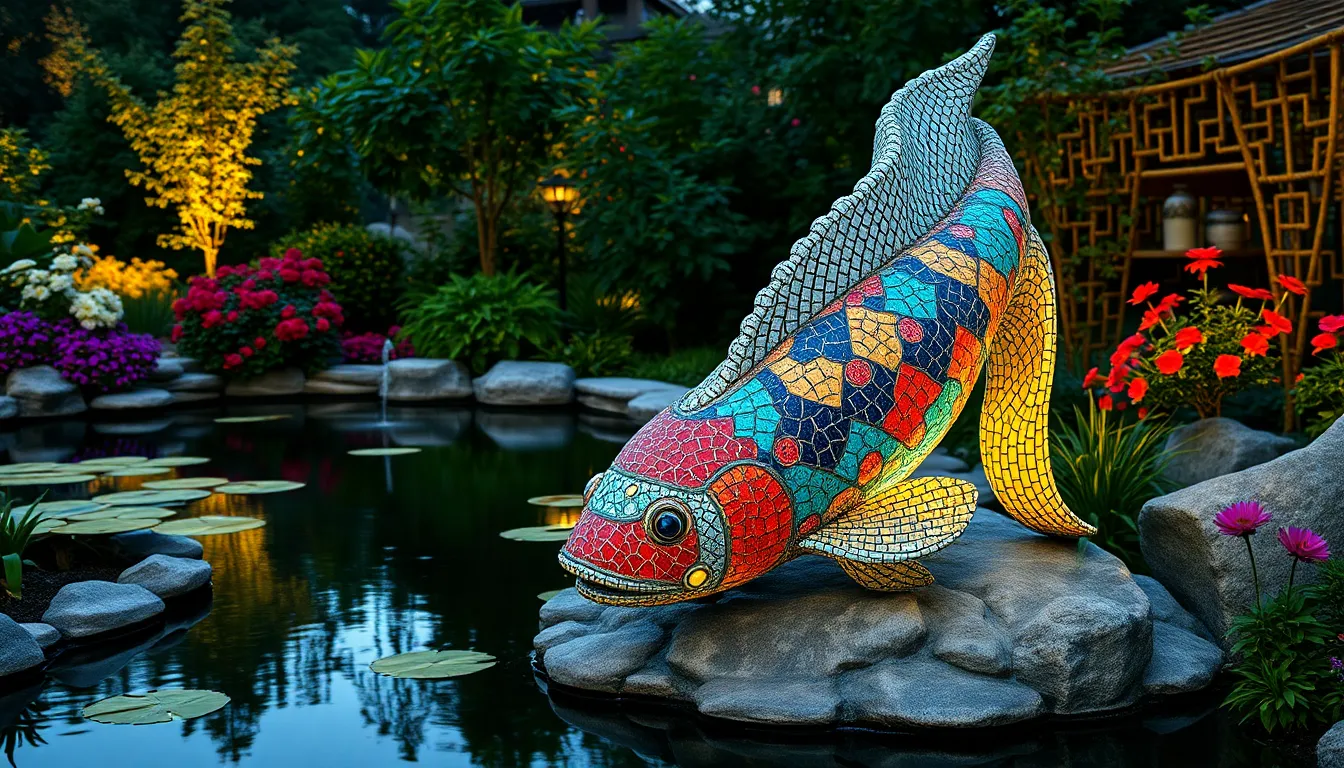
Moving beyond flat surfaces, three-dimensional mosaic sculptures transform gardens into immersive art galleries that captivate visitors from every angle.
Design Three-Dimensional Statement Pieces
Three-dimensional mosaics offer endless possibilities for creating irregular shapes and sculptural forms that serve as dramatic garden centerpieces. We can create stunning mosaic koi pools that extend pond beauty with colorful tiles and decorative figurines, creating aquatic wonderlands that blend seamlessly with natural water features. Whimsical wall art featuring sea life mosaics combines watery hues with native plantings to establish serene garden oases.
Upcycled planters represent another creative approach, transforming ordinary cement blocks into artistic containers perfect for showcasing bright flowers like Sweet William. These sculptural pieces add vertical interest while maintaining functionality for plant growth and seasonal displays.
Illuminated mosaics incorporate strategic lighting placement to ensure visibility during nighttime hours, adding an extra layer of beauty that extends garden enjoyment into evening hours. Nature-inspired designs using pebbles and stone create earthy, concentric patterns that complement organic garden themes while providing textural contrast against softer plantings.
Incorporate Lighting for Evening Display
Solar-powered lights offer maintenance-free illumination for mosaic art pieces, creating magical ambiance without requiring electrical connections or ongoing energy costs. These sustainable lighting answers automatically activate at dusk, highlighting intricate mosaic details and extending visual impact throughout evening hours.
String lights wrapped around mosaic sculptures add whimsical glow effects that transform ordinary garden features into enchanting focal points. We recommend positioning lights to emphasize dimensional aspects of sculptures while avoiding harsh shadows that might diminish artistic details.
LED strip lighting embedded within mosaic installations creates subtle backlighting effects that enhance glass and metallic tile reflections. This technique works particularly well for wall-mounted pieces where indirect lighting can create dramatic silhouettes against surrounding plantings.
Position for Maximum Visual Impact
Central focal points featuring large-scale mosaics like decorative bathing mermaids draw immediate visual attention while creating ever-changing movement throughout garden spaces. These statement pieces work best when positioned at natural gathering areas or viewpoints where visitors naturally pause to appreciate garden beauty.
Pathway accents using mosaic stepping stones guide visitors through garden areas while creating meandering routes that invite exploration and discovery. We suggest spacing these elements to establish comfortable walking rhythms while maintaining artistic continuity between different garden zones.
Strategic placement near seating areas ensures that intricate mosaic details remain visible and appreciated during relaxation periods. Consider viewing angles from multiple positions to maximize the sculptural impact of three-dimensional pieces throughout different seasons and lighting conditions.
Install Mosaic Accents on Garden Structures
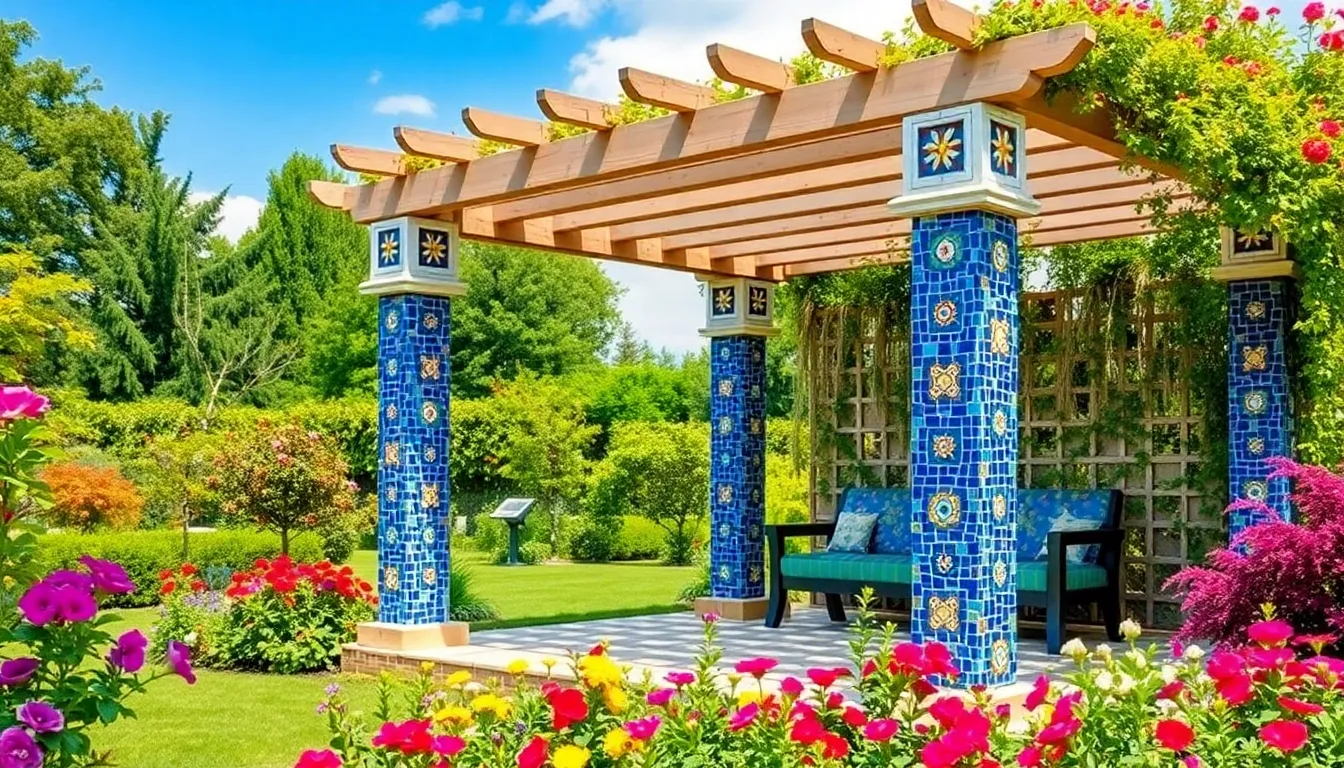
Transform your garden’s architectural elements into stunning artistic features that elevate the entire outdoor experience. Adding mosaic accents to existing structures creates cohesive design themes while maximizing visual impact.
Enhance Pergolas, Arbors, and Gazebos
Decorating pergola pillars with mosaic tiles creates dramatic vertical focal points that draw the eye upward throughout your garden space. We can apply colorful ceramic or glass tiles to concrete or wooden posts using weather-resistant adhesives, creating stunning columns that reflect light beautifully. Natural stone mosaics work particularly well for rustic garden themes, while glass tiles complement modern industry designs.
Mosaic bench accents transform simple seating into comfortable art installations where guests can appreciate the craftsmanship up close. Adding tile patterns to bench backs and armrests creates inviting spaces that encourage longer garden visits. Geometric designs work exceptionally well for pergola seating, providing visual interest without overwhelming the natural surroundings.
Gazebo roof accents offer unique opportunities to create overhead artistic displays that surprise visitors with unexpected beauty. We recommend using lightweight materials like ceramic tiles or recycled glass to avoid structural stress while maintaining visual impact. Strategic placement of mirror tiles can reflect garden colors and create ever-changing light patterns throughout the day.
Add Decorative Elements to Utility Features
Mosaic stepping stones create vibrant pathways that guide visitors through your garden while adding artistic flair to functional walkways. These decorative elements blend seamlessly with existing industry features, using materials like natural stone and ceramic tiles that withstand foot traffic and weather conditions. Color schemes can coordinate with seasonal plantings, creating ever-changing visual connections throughout your outdoor space.
Terracotta pot transformations turn ordinary planters into stunning garden art pieces that enhance plant displays with colorful tile borders and patterns. We can prepare surfaces by cleaning and sanding glossy finishes to ensure strong adhesion between tiles and containers. Drainage considerations remain essential for plant health, requiring careful maintenance of existing holes while applying waterproof sealants to protect the mosaic work.
Fountain enhancements incorporate mosaic tiles into water feature designs, creating visually striking elements that serve as garden centerpieces. Glass tiles work particularly well for water applications, reflecting light and creating shimmering effects that complement flowing water. Strategic placement around fountain bases and spillways adds artistic detail without interfering with water circulation.
Maintain Structural Integrity While Adding Beauty
Water and frost resistant materials ensure your mosaic installations withstand outdoor conditions while maintaining their vibrant appearance year after year. We must select cement and grout specifically formulated for exterior applications, providing durability against freeze thaw cycles and moisture exposure. Professional grade adhesives designed for outdoor use create lasting bonds between tiles and various substrate materials.
Appropriate material selection involves choosing glass, stone, or marble tiles that complement your garden’s climate and aesthetic requirements. Natural stone options like slate and granite offer excellent weather resistance while providing organic textures that blend with industry elements. Porcelain tiles resist fading and moisture absorption, making them ideal choices for high traffic areas and exposed locations.
Proper installation techniques protect both the artistic elements and underlying structures through careful surface preparation and sealing procedures. Base preparation includes cleaning, priming, and creating level surfaces that support tile weight without compromising structural integrity. Regular maintenance schedules help preserve both the mosaic artwork and the garden structures they enhance, ensuring long lasting beauty throughout changing seasons.
Plan and Execute Your Garden Mosaic Project Successfully
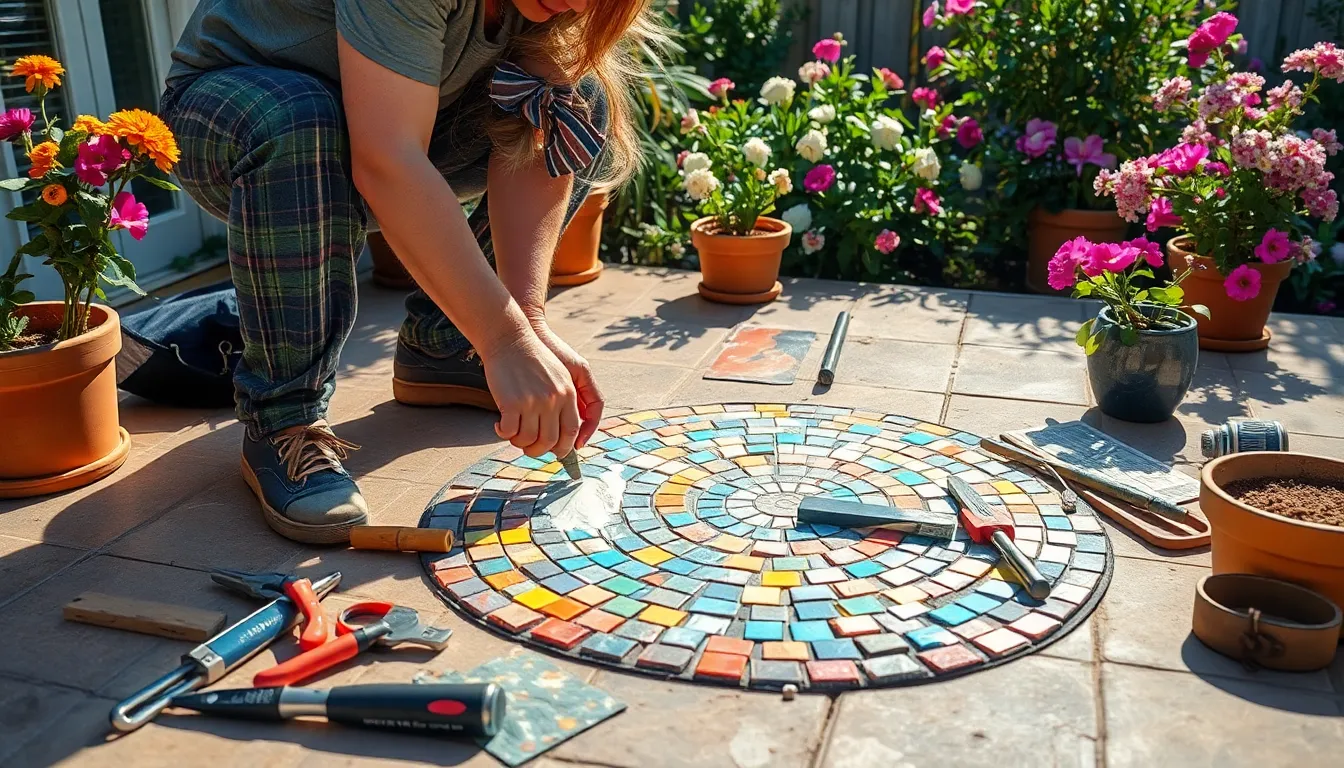
Successful garden mosaic projects require careful preparation and methodical execution. We’ll guide you through the essential steps to ensure your mosaic features enhance your outdoor space for years to come.
Gather Essential Tools and Materials
Materials form the foundation of any stunning garden mosaic project. We recommend selecting from marble, glass, stone, wood tiles, and pebbles based on your design vision and budget. Glass tiles create brilliant light reflections while marble provides timeless elegance for pathways and borders.
Adhesives must withstand outdoor conditions year-round. Water and frost-resistant cement ensures your mosaic installations remain secure through seasonal temperature changes and moisture exposure. Standard indoor adhesives won’t provide the durability needed for garden applications.
Grout selection impacts both appearance and longevity. Sanded grout delivers the coarse texture necessary for outdoor installations while filling gaps between larger mosaic pieces effectively. This type of grout handles weather exposure better than unsanded alternatives.
Tools streamline the installation process significantly. Essential items include a trowel for spreading adhesive evenly, protective gloves for handling sharp materials safely, and soft rags for cleaning excess grout during application. Quality tools prevent installation delays and ensure professional results.
Follow Proper Installation Techniques
Installation methods depend on your project location and timeline. The direct method works best for on-site construction where you can build your mosaic directly on the intended surface like garden walls or pathways. The indirect method suits situations requiring off-site creation followed by later installation at the final location.
Adhesive application requires proper depth for outdoor durability. We apply cement-based adhesive evenly across the surface using consistent pressure to eliminate air pockets that could cause future tile displacement. Proper coverage ensures each mosaic piece bonds securely to the substrate.
Grout mixing achieves optimal consistency for outdoor applications. Mix grout to a cottage cheese texture that spreads easily without being too wet or dry. Apply the mixture using diagonal motions to fill all gaps completely, then clean excess material with a damp rag before it hardens.
Secure installation on walls and pathways prevents future problems. Use appropriate mounting hardware for vertical surfaces and ensure proper drainage for horizontal installations. Level surfaces and adequate support structures maintain the integrity of your mosaic features over time.
Maintain Your Mosaic Garden Features
Regular cleaning preserves the beauty of your mosaic installations. Use a soft brush with clean water to remove debris, dirt, and organic matter that accumulates naturally in outdoor environments. Avoid harsh chemicals that could damage grout or discolor mosaic materials.
Sealing protects your investment from weather damage. Apply a high-quality sealer 48 hours after grouting completion to create a protective barrier against moisture penetration and freeze-thaw cycles. This crucial step extends the lifespan of your garden mosaic features significantly.
Seasonal inspections identify maintenance needs early. Check for loose tiles, cracked grout, or drainage issues that could compromise your mosaic installations. Address minor problems promptly to prevent costly repairs or complete replacement of damaged sections.
Professional maintenance schedules ensure long-term durability. Plan annual deep cleaning and resealing for high-traffic areas like pathways and frequently used seating areas. Document any repairs or maintenance performed to track the condition of your garden mosaic features over time.
Conclusion
We’ve explored how garden mosaics can completely transform your outdoor space into a personalized work of art. From stepping stones to sculptures these versatile features offer endless possibilities for creative expression while maintaining functionality.
The beauty of mosaic projects lies in their accessibility to all skill levels and budgets. Whether you’re starting with simple plant markers or tackling ambitious wall installations you’ll find techniques that match your abilities and vision.
Remember that successful mosaic projects require quality materials and proper installation methods. With regular maintenance and seasonal care your artistic garden features will continue bringing joy and visual interest for years to come.
Now it’s time to pick up your tools and start creating the garden mosaic masterpiece you’ve been dreaming of. Your unique outdoor gallery awaits!
Frequently Asked Questions
What are garden mosaics and how do they enhance outdoor spaces?
Garden mosaics are artistic installations made from small pieces of materials like ceramic, glass, or stone arranged to create decorative patterns. They transform ordinary garden elements into stunning focal points, adding visual appeal and personality to outdoor spaces. Mosaics can be incorporated into stepping stones, planters, walls, and sculptures, making them versatile additions suitable for any garden style while creating memorable artistic walkways and features.
What materials work best for outdoor mosaic projects?
Durable, weather-resistant materials are essential for outdoor mosaics. Natural stone, ceramic tiles, porcelain, and glass work well as they can withstand freeze-thaw cycles and moisture. For adhesives, use outdoor-appropriate waterproof options, and ensure proper sealing with UV-resistant products. Avoid materials that may crack or fade in sunlight, and always choose non-toxic options for water features that attract wildlife.
How do I create mosaic stepping stones for garden pathways?
Start with a solid base preparation and select durable materials like natural stone or ceramic. Plan your design pattern to complement your garden style – geometric shapes for modern gardens or organic designs for cottage styles. Use proper adhesive selection, apply grout carefully, and seal the finished stones. Ensure adequate spacing between stones and consider the pathway’s overall flow for both functionality and aesthetic appeal.
Can beginners successfully create garden mosaics?
Absolutely! Garden mosaics are accessible to gardeners of all skill levels. Start with simple projects like small stepping stones or planter accents. Focus on basic techniques like proper surface preparation, selecting appropriate materials, and learning fundamental grouting methods. Begin with geometric patterns before attempting complex designs, and don’t hesitate to practice on small test pieces first to build confidence and skills.
How do I maintain garden mosaics throughout the seasons?
Regular maintenance includes cleaning surfaces with mild soap and water, checking for loose tiles, and resealing annually to protect against moisture. Conduct seasonal inspections to identify any damage from freeze-thaw cycles or weather exposure. Remove debris that might trap moisture, and consider professional maintenance schedules for large installations. Proper initial installation with quality materials significantly reduces long-term maintenance requirements.
What design considerations should I keep in mind for mosaic garden walls?
Plan large-scale patterns that complement your garden’s natural elements and viewing distances. Use cohesive color palettes that harmonize with surrounding plantings and consider seasonal lighting effects on design visibility. Scale patterns appropriately – larger designs for distant viewing, intricate details for close-up appreciation. Incorporate mixed media for texture and visual interest, and ensure the design serves both aesthetic and functional purposes like privacy screening.
How do I choose colors and patterns for different garden styles?
Modern gardens benefit from geometric patterns with clean lines and monochromatic or contrasting color schemes. Cottage gardens work well with organic, flowing designs using soft, natural colors that blend with plantings. Consider seasonal color changes in your garden when selecting mosaic hues. Mediterranean styles suit warm earth tones and intricate patterns, while minimalist gardens prefer subtle, understated designs with neutral palettes.
What safety considerations are important for mosaic water features?
Use only non-toxic materials to ensure wildlife safety, especially for bird baths and fountains. Create smooth surfaces for easy cleaning and maintenance, and design gentle slopes for proper water drainage. Position water features for optimal visibility while ensuring structural stability. Install proper electrical connections for pumps using GFCI outlets, and consider freeze protection in colder climates to prevent damage to both mosaics and plumbing components.

